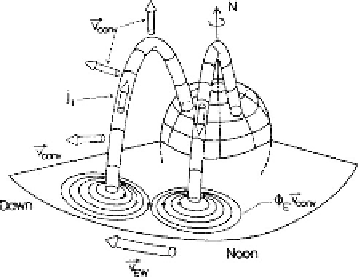Geoscience Reference
In-Depth Information
Fig. 9.5.
Twin-vortex ionospheric equivalent current system generated by the re-
connection of the interplanetary magnetic field with the geomagnetic magnetic field.
Two field-aligned currents flow into each hemisphere. After Glassmeier
et al.
[7]
Thus, it is possible to argue, that the seasonal anomaly of the rotation an-
gle of the magnetic field, main polarization axis may be explained within the
framework of the model considered above.
Near the equator where the current system of the Southern Hemisphere
is closed, additional regions appear, where the terminator effect significantly
decreases. In our simulations, these regions are at colatitude
85
◦
.
≈
Twin-Vortex Current
Glassmeier [8] extracted a special type of high-latitude long-period pulsa-
tions. Their magnetic effect on the ground may be expressed in terms of an
equivalent twin-vortex current system that moves along the Earth's surface at
2-5 km/s. One vortex rotates clockwise and the other counter-clockwise (see
Fig. 9.5). Pulsations such as these were said to be the result of the recon-
nection of geomagnetic and interplanetary magnetic fields on the dayside of
the magnetosphere. Next, these ULF MHD perturbations are carried by an
Alfven wave to the conjugate hemisphere. The pair of field-aligned currents
brought by the Alfven wave form a closed circuit through the ionosphere. To
summarize, the equivalent twin-vortex current system that had been created
in the dayside magnetosphere reappears in the ionosphere.
During the equinox (Figure 9.5), part of the west vortex closes on the
middle and high latitudes. Due to the low conductivity during nighttime, the
low-latitude part of the current turns southward to the terminator and flows
along the equator. Thereafter, the current closes on the equatorial ionosphere.
Currents in the Northern and Southern Hemispheres have the same direction
in the equatorial region. Therefore, the total equatorial current is doubled in
the equatorial region.
Seasonal changes do not significantly influence the general distribution of
the equivalent current system. Much as it does during equinox, the current

Search WWH ::

Custom Search